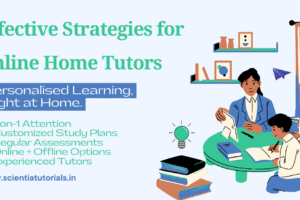Setting Boundaries and Expectations in a Home Tutoring Environment
Establishing a Productive Learning Space: Teaching Tips for Home Tutors on Setting Boundaries and Expectations
Introduction
In the dynamic environment of home tutoring, establishing clear boundaries and expectations is essential for creating a conducive learning atmosphere. Whether you are working with young children, teenagers, or adult learners, a structured approach helps ensure that both the tutor and the student can maximize their time together. Setting boundaries clarifies the roles and responsibilities of each party, enhances communication, and fosters respect. This article delves into the critical elements of setting boundaries and expectations in a home tutoring environment, providing practical tips and strategies for home tutors to implement effectively.
The Importance of Setting Boundaries and Expectations
1. Clarity and Structure
Setting clear boundaries and expectations provides a framework for the tutoring sessions. Students are more likely to engage and perform better when they understand what is required of them and what they can expect from their tutor. This structure creates an environment conducive to learning, reducing uncertainty and anxiety.
2. Mutual Respect
Establishing boundaries fosters mutual respect between the tutor and the student. When both parties understand their roles, it cultivates a sense of professionalism and accountability, which is crucial for a successful tutoring relationship.
3. Enhanced Communication
When boundaries are clearly defined, communication becomes more effective. Both the tutor and the student can express their needs, concerns, and feedback openly, creating a more collaborative and productive learning environment.
Setting Up Boundaries in a Home Tutoring Environment
1. Define the Physical Space
- Choose an Appropriate Location: The tutoring space should be a designated area that is free from distractions. Ideally, it should be quiet, well-lit, and equipped with necessary materials. Communicate this choice with the student and their parents to ensure everyone understands where the sessions will take place.
- Create a Learning Zone: Decorate the tutoring space with educational materials, learning resources, and student work. This not only sets the mood for learning but also reinforces the purpose of the space.
2. Establish Time Boundaries
- Set Clear Start and End Times: Establish consistent start and end times for each tutoring session. This structure helps both the tutor and the student manage their time effectively and prepares the student for focused learning periods.
- Implement a Cancellation Policy: Outline a cancellation policy that respects both parties’ time. For example, if a student cancels less than 24 hours in advance, they may be charged a fee or expected to reschedule. This policy fosters accountability and reduces last-minute cancellations.
3. Define Behavioral Expectations
- Discuss Code of Conduct: At the beginning of the tutoring relationship, discuss acceptable behavior during sessions. This may include being respectful, staying on topic, and being attentive. Make sure students understand the consequences of not adhering to these behavioral expectations.
- Encourage Active Participation: Encourage students to ask questions and participate actively in discussions. This creates a dynamic learning environment and reinforces the idea that they are responsible for their own learning.
Setting Academic Expectations
1. Define Learning Goals
- Collaborate on Objectives: At the start of the tutoring relationship, work with the student to set specific learning goals. These should be realistic, measurable, and tailored to the student’s needs and aspirations. For instance, if a student struggles with math, a goal might be to improve their grades by a certain percentage within a defined time frame.
- Regularly Review Progress: Schedule regular check-ins to assess progress toward the established goals. This helps students stay motivated and reinforces the importance of accountability in their learning journey.
2. Communicate Homework and Assignment Expectations
- Establish Homework Guidelines: Clearly outline the expectations for homework and assignments. This may include deadlines, the expected level of effort, and how to ask for help if they encounter difficulties.
- Monitor Homework Completion: Keep track of the student’s homework and assignments to ensure they are completed on time. Discuss any challenges they face and work collaboratively to find solutions.
Building a Positive Tutor-Student Relationship
1. Foster Open Communication
- Encourage Questions and Feedback: Create an environment where students feel comfortable asking questions and providing feedback. This not only helps clarify any misunderstandings but also strengthens the tutor-student relationship.
- Use Positive Reinforcement: Recognize and praise students for their efforts and achievements, no matter how small. Positive reinforcement boosts confidence and motivates students to continue striving for success.
2. Be Flexible Yet Consistent
- Adapt to Individual Needs: While it’s essential to set boundaries and expectations, be open to adapting your approach based on individual student needs. Flexibility in your methods can lead to more significant breakthroughs in learning.
- Maintain Consistency: While being flexible, ensure that core boundaries and expectations remain consistent. This balance builds trust and security in the tutoring relationship.
Engaging Parents in the Process
1. Involve Parents in Goal Setting
- Set Expectations Together: Involve parents in the goal-setting process. Discuss the academic objectives and behavioral expectations you’ve established with the student. This collaboration fosters a unified approach to the student’s education.
- Provide Regular Updates: Keep parents informed of their child’s progress and any challenges they may face. Regular communication helps parents understand how they can support their child’s learning at home.
2. Encourage Parental Support
- Suggest Strategies for Home: Provide parents with strategies and resources to reinforce learning at home. This may include study tips, recommended reading materials, or educational apps that complement your tutoring sessions.
- Create a Partnership: Emphasize that the tutor-parent relationship is a partnership aimed at the student’s success. Encourage parents to reach out with any concerns or feedback regarding the tutoring sessions.
Handling Challenges in Setting Boundaries and Expectations
1. Addressing Disruptive Behavior
- Implement a Warning System: If a student displays disruptive behavior, implement a warning system where they receive verbal warnings followed by consequences if the behavior persists. This approach encourages students to self-correct and be accountable for their actions.
- Discuss Behavior Privately: If a student consistently struggles with behavior, address it privately rather than publicly shaming them. Open a dialogue to understand the root of the issue and collaboratively find solutions.
2. Revisiting Boundaries and Expectations
- Regular Check-Ins: Schedule regular discussions with students to revisit the boundaries and expectations set at the beginning. This allows for adjustments as needed and reinforces the importance of maintaining a productive learning environment.
- Encourage Self-Reflection: Encourage students to reflect on their behavior and how it aligns with the established expectations. This self-awareness helps them recognize areas for improvement and take ownership of their actions.
Conclusion
Setting boundaries and expectations is crucial for creating a productive home tutoring environment. Through clear communication, mutual respect, and collaborative goal-setting, tutors can cultivate a space that fosters positive learning behaviors. By engaging students in the process and involving parents as partners, tutors can build a strong foundation for academic success. While challenges may arise, addressing them with consistency and empathy will reinforce the importance of maintaining boundaries. Ultimately, a well-structured tutoring experience not only enhances learning outcomes but also empowers students to take charge of their education, fostering a lifelong love for learning.



